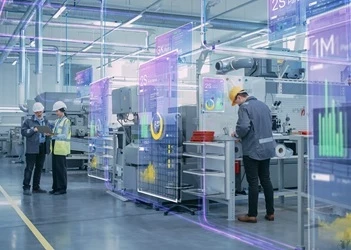Digital twins in aerospace-defense are critical to digital transformation
Department of Defense (DoD) branches are developing and deploying digital transformation strategies including digital twins
Add bookmark
Digital twins in aerospace-defense play a critical role in the digital transformation of the industry. That’s according to a new report from the Digital Twin Consortium (DTC).
The Aerospace-Defense: Digital Twin Research and Technology Gap Analysis paper examines the opportunities and challenges of digital twin adoption in the aerospace-defense sector and sets out recommendations for implementing digital twins throughout the product lifecycle.
The DTC believes digital twins can empower aerospace-defense industry stakeholders to integrate faster, manage complexity and optimize lifecycle outcomes.
Join the PEX Network community

Don't miss any news, updates or insider tips from PEX Network by getting them delivered to your inbox. Sign up to our newsletter and join our community of experts.
Learn MoreDigital twins in aerospace-defense
Opportunities
Digital twin opportunities in aerospace-defense include improved data governance that enables better artificial intelligence (AI) driven predictions, optimized maintenance and sustainment that provides integrated digital twin data and supports cost-efficient, condition-based maintenance (CBM) and faster innovation cycles for standardized data policies which accelerate research and development (R&D) for next-generation military systems.
Digital twin challenges
Challenges include data silos and integration issues whereby legacy systems may lack compatibility with modern digital twin architectures. What’s more, digital twins generate massive data streams that must be securely managed against evolving cyber threats.
A key conclusion of the research is the need to examine the standards that currently support the development of digital twins, identify gaps in the governance landscape and establish expectations for the future.
By focusing on cross-functional and tailorable standardization, stakeholder needs and objectives become more achievable, resulting in affordable solutions that shorten test, demonstration, certification and verification, thereby decreasing lifecycle cost while increasing product performance and availability, the report read.
“Standards-based alignment of digital thread and digital twin capabilities is critical for enabling scalable, interoperable systems across the Department of Defense,” said Dan Isaacs, general manager and chief technology officer (CTO) at the DTC.
Digital twins are vital for defense
Digital twins in the defense ecosystem are vital for weapon systems, logistics, maintenance and readiness, according to Brian Schmidt, co-chair of the DTC Aerospace and Defense Working Group and technical fellow and chief engineer at Northrop Grumman.
The government directive DoD 5000.97 calls for using digital engineering methodologies, technologies and practices across the lifecycle of defense acquisition programs. “It places stringent security controls on sensitive and classified data, vital for digital twins used in military applications,” Schmidt said.
All Department of Defense (DoD) branches are developing and deploying digital transformation strategies including digital twins, added David Shaw, co-chair of the Aerospace and Defense Working Group and president and CEO at Intuitus Corporation. “We must examine the standards that currently support digital twins, identify gaps in the governance landscape, set expectations on future standard development, develop advocacy and make recommendations for a path forward.”
Advancing digital twins in aerospace-defense
The DTC has several recommendations for advancing the use of digital twins in aerospace-defense. These include:
- Examining the standards that currently support digital twins.
- Identifying and managing requirements that support interoperability between digital twins throughout the lifecycle.
- Making twin model calibration an automated process that is applicable to dynamically varying model parameters.
- Considering cybersecurity concerns at the onset of conceiving and building a digital twin program.
- Establishing a cross-functional focus that identifies specific standards that guide all stakeholders, ensuring that engineering and data exchanges are harmonized at a contractually required and understood digital twin maturity level.
- Using clear and measurable success criteria regarding digital twin performance.
- Applying DoD Data Strategy (Department of Defense, 2020) to establish policies and frameworks for managing and standardizing data across defense acquisition programs.
All Access: Future of BPM 2026

You asked, and we listened. Business process management (BPM) remains the cornerstone technology for driving organizational transformation, according to the survey results featured in the latest PEX Report. As we look toward 2026 and beyond, generative AI, agentic AI, and intelligent process orchestration are redefining how processes are designed, executed, and optimized. BPM is your key to adapting swiftly and effectively in this new era.
PEX Network is bringing together industry leaders, technology innovators, and thought leaders to answer your biggest questions and explore the advancements reshaping business today. And you're invited. Register for free to save your spot now!
Register Now












